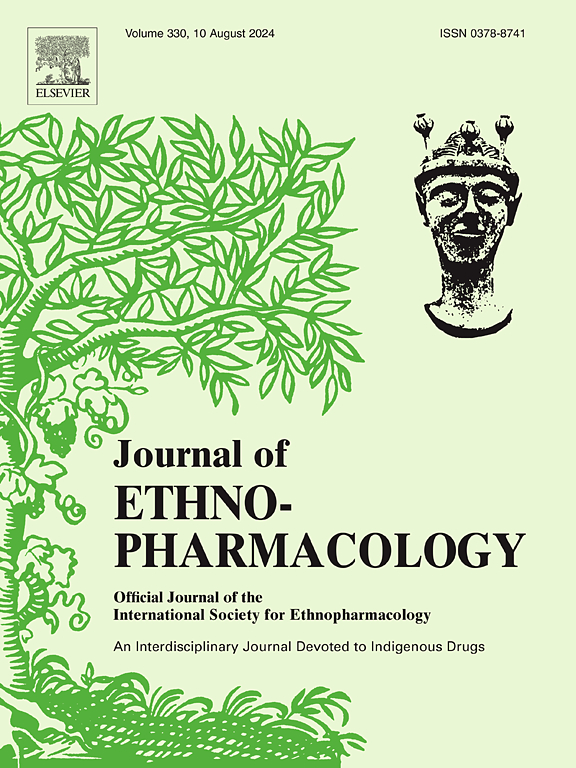The anti-inflammatory effects of paeonol from Cynanchum paniculatum extracts on LPS-induced macrophage RAW 264.7 cells and Helicobacter pylori-infected gastrointestinal mucosal damaged zebrafish
IF 4.8
2区 医学
Q1 CHEMISTRY, MEDICINAL
引用次数: 0
Abstract
Ethnopharmacological relevance
Paeonol has often been used as an anti-inflammatory agent in gastrointestinal diseases. However, as a primary paeonol-originated herb, the effects of Cynanchum paniculatum (CP) extracts have rarely been reported in the study on gastrointestinal inflammation models.
Aim of the study
The study aims to investigate the anti-inflammatory effects of different CP extracts, including the volatile extract (CP-VE), and its aqueous extract (CP-AE), based on their different contents of paeonol.
Methods
The contents of paeonol in the extracts were detected by HPLC. The anti-inflammatory effects of CP-VE, CP-AE and their combination (CP-VA), were compared on lipopolysaccharide (LPS)-induced macrophage RAW264.7 cells, with which the primary mechanisms were investigated in MAPK/NF-κB signaling pathway. Additionally, the effects of CP-VE at different dosages were further investigated on Helicobacter pylori (Hp)-infected gastrointestinal mucosal damaged zebrafish.
Results
The content of paeonol in CP-VE was 93.29%, while that in CP-AE was 0.03%. The cellular study showed that the levels of IL-1β, IL-6, TNF-α and reactive oxygen species (ROS) were significantly decreased in the CP-extract groups when compared with the model group, while their levels of IL-10 and nitric oxide (NO) were significantly increased. Compared with the LPS group, p-P65, p-JNK, p-ERK and NLRP3 protein expression was decreased in the CP-extract groups with different degrees, where CP-VA exhibited the most pronounced inhibitory activities on the phosphorylation of the proteins (p < 0.001, p < 0.01). CP-AE and CP-VE demonstrated the similar inhibition of ERK and P65 phosphorylation, while CP-AE showed slightly superior inhibition of P38, and NLRP3 than CP-VE did (p < 0.05, p < 0.01). The zebrafish study indicated that the CP-VE groups showed obvious reductions in the gastrointestinal tract areas, the fluorescence intensities and gastrointestinal neutrophil counts in a dose-dependence style, when compared with the model group. The histopathological results also indicated that CP-VE showed significant effects on the pathologic structure of the intestinal mucosa.
Conclusion
The results showed that CP-VE (40 μg/mL) and CP-AE (700 μg/mL) showed similar significantly anti-inflammatory activity on LPS-induced macrophage RAW 264.7 cells, which indicated that the activity might be not fully related with paeonol content. It is also speculated that both CP-VE and CP-AE may exert their anti-inflammatory effects via inhibiting the MAPK/NF-κB pathways. CP-extracts are expected to be potential anti-inflammatory agents from natural source in gastrointestinal inflammation-related indications, among which CP-AE need to be further investigated on its pharmacological material basis in a more comprehensive manner.

求助全文
约1分钟内获得全文
求助全文
来源期刊

Journal of ethnopharmacology
医学-全科医学与补充医学
CiteScore
10.30
自引率
5.60%
发文量
967
审稿时长
77 days
期刊介绍:
The Journal of Ethnopharmacology is dedicated to the exchange of information and understandings about people''s use of plants, fungi, animals, microorganisms and minerals and their biological and pharmacological effects based on the principles established through international conventions. Early people confronted with illness and disease, discovered a wealth of useful therapeutic agents in the plant and animal kingdoms. The empirical knowledge of these medicinal substances and their toxic potential was passed on by oral tradition and sometimes recorded in herbals and other texts on materia medica. Many valuable drugs of today (e.g., atropine, ephedrine, tubocurarine, digoxin, reserpine) came into use through the study of indigenous remedies. Chemists continue to use plant-derived drugs (e.g., morphine, taxol, physostigmine, quinidine, emetine) as prototypes in their attempts to develop more effective and less toxic medicinals.
 求助内容:
求助内容: 应助结果提醒方式:
应助结果提醒方式:


